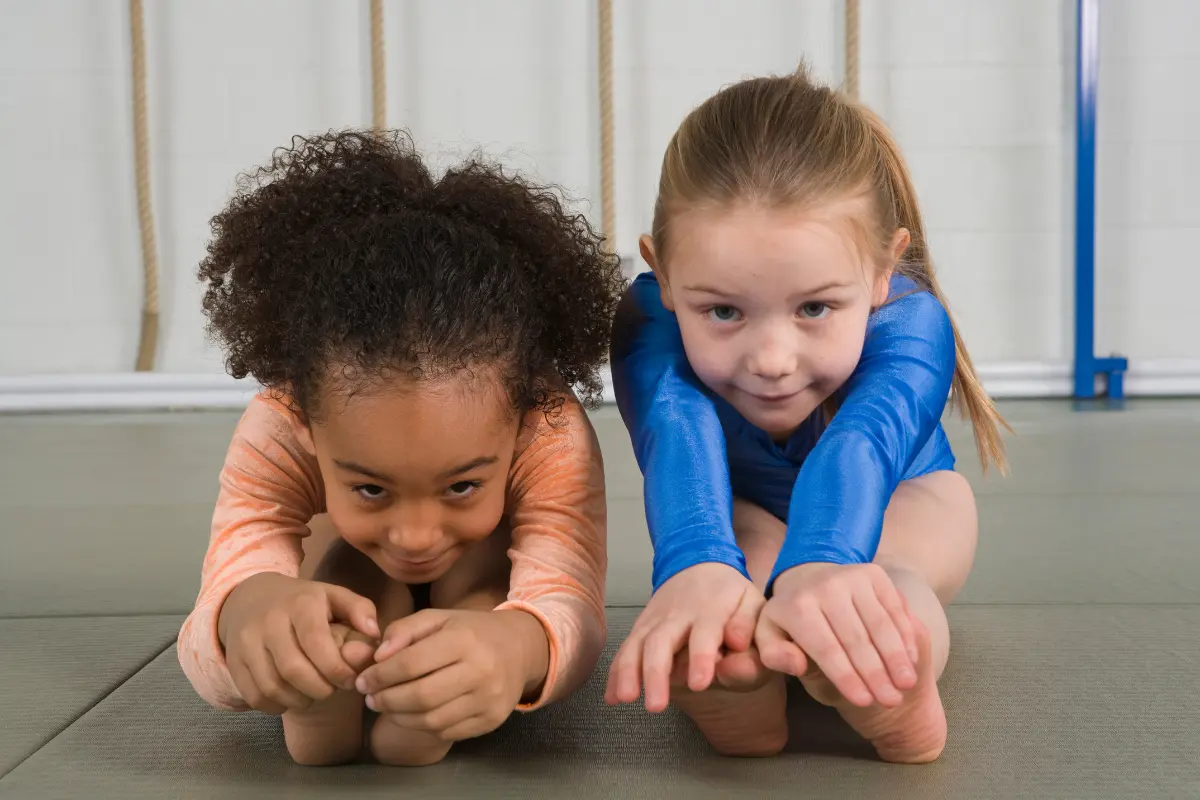In the USA Gymnastics Development Program, young athletes follow a clearly defined path through two major phases: compulsory and optional levels. Compulsory levels focus on mastering consistent technique, optional levels introduce freedom of expression, higher-level skills, and personalized routines. Each phase plays a distinct role in a gymnast’s journey.
What Are Compulsory Levels?
In the USA Gymnastics Development Program, compulsory levels include:
- Levels 1–3: Developmental stages (often used for training or local meets)
- Levels 4 & 5: Official compulsory competition levels
At Levels 4 and 5, every gymnast in the country performs identical routines on each apparatus: vault, uneven bars, balance beam, and floor exercise.
These routines are created by USA Gymnastics and published in the Women’s Development Program Compulsory Code of Points, updated once every four years (a quadrennium). This ensures uniformity in judging and coaching and helps athletes focus on building clean, efficient movement patterns.
How Do Gymnasts Move Up?
Advancement through the compulsory levels is based on all-around (AA) scores at sanctioned meets:
- Level 4 to 5: Requires a 34.00 AA
- Level 5 to 6: Requires a 32.00 AA
New for 2024: A gymnast may skip Level 5 entirely if she earns two 36.00+ AA scores at Level 4. This rule recognizes athletes who already demonstrate exceptional technique and allows them to move directly into Level 6, the first optional level.
Source: USA Gymnastics 2024 Rules & Policies
Training the Compulsory Way
Training Compulsory gymnastics prioritizes quality over quantity. Gymnasts typically train 12 to 16 hours per week, with workouts focused on refining body positions, strength, and consistency.
Training methods include:
- 30 minutes on tight body shapes
- 15 minutes of heel snaps across the floor
- Handstand holds against a wall to build balance and body control
- Mirror work, video replay, or laser beam lines to perfect alignment and timing
Repetition is key. By performing the same routines meet after meet, gymnasts build muscle memory and mental discipline.
What Are Optional Levels in Gymnastics?
In the USA Gymnastics Development Program, Levels 6 through 10 are known as optional levels. This phase marks a big transition: athletes now perform custom routines tailored to their own strengths and style.
No two optional routines are the same. Gymnasts and their coaches choreograph performances that showcase individual talents
Optional Levels Breakdown
| Level | Minimum Age | Skill Requirements | Mobility Score |
|---|---|---|---|
| Level 6 | 7 years | 5 A skills + 1 B skill; basic acro and dance | 32.00 AA from Level 5 |
| Level 7 | 7 years | 5 A + 2 B skills; slightly higher difficulty | 32.00 AA from Level 6 |
| Level 8 | 8 years | 4 A + 4 B skills; complete tumbling passes | 34.00 AA from Level 7 |
| Level 9 | 8 years | 3 A + 4 B + 1 C skill; advanced routines | 34.00 AA from Level 8 |
| Level 10 | 9 years | 3 A + 3 B + 2 C skills; elite-level content | 34.00 AA from Level 9 |
AA stands for All-Around score, which is the combined total from all four events.
Key Features of Optional Gymnastics
1. Custom Routines
Each gymnast works with their coach to build routines on vault, bars, beam, and floor that showcase their individual talents—like powerful tumbling, strong dance lines, or unique combinations. Routines must still meet specific skill and composition requirements, but the choreography is personalized.
2. Creativity and Style
Optional levels are where gymnasts really get to express themselves, especially on beam and floor. Music, rhythm, choreography, and body movement all come into play, making routines feel more like performances than drills.
3. Increased Difficulty
From Level 6 to Level 10, the complexity of required elements steadily increases. Gymnasts perform higher-difficulty skills—such as flight series on beam, release moves on bars, and twisting saltos on floor—and may even begin introducing C, D, and E-rated elements (based on the FIG skill rating system).
4. New Scoring System
Optional routines are judged using two main components:
- D-score (Difficulty Score): Based on the number and value of skills in the routine.
- E-score (Execution Score): Starts from 10.0, with deductions for form, balance, technique, and artistry.
All routines must include:
- Special Requirements (SRs): Specific types of elements required by that level
- Value Parts (VPs): A set number of A, B, and C-rated skills, depending on the level
- Composition & Artistry: Judges also evaluate how well the skills are arranged and performed, including creativity, rhythm, and flow.
Optional gymnastics is where gymnasts develop their own style, strategy, and strength. It’s also a stepping stone to higher goals like college scholarships, elite-level competition, or even the Olympic track.
Summary: From Scripted to Freestyle
Compulsory and optional gymnastics are two important parts of a gymnast’s journey. In compulsory levels, gymnasts focus on learning strong basics by doing the same routines as everyone else. It’s all about clean technique and building confidence.
Once they reach the optional levels, gymnasts get to show off their personality and skills with custom routines. They take what they’ve learned and start performing more difficult moves with creativity and style.
Both stages matter. Compulsory gymnastics builds the foundation. Optional gymnastics brings it to life.













